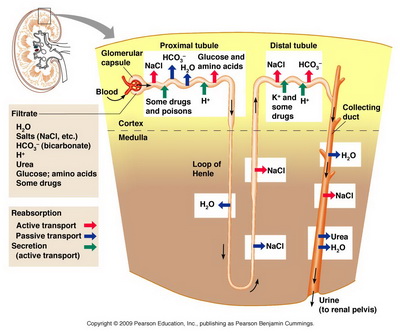Once solutes have been filtered out from plasma into filtrate, how are they reabsorbed into the blood?
1 Answer
They are reabsorbed by tubules in the kidney nephrons.
Explanation:
The glomerulus, at the entrance to the nephron, filters almost everything from the blood except blood cells and most proteins.
The filtrate is made up of water, urea, ions (e.g.
About 99 % of this filtrate is reabsorbed by the urinary system.

(from droualb.faculty.mjc.edu)
The Proximal Convoluted Tubule (PCT)
The PCT reabsorbs about 80 % of the water, ions, organic nutrients, and small proteins in the filtrate.
Almost all the solutes are selectively moved to the plasma by transport proteins.
Following their removal, most of the water is reabsorbed by osmosis.
The Loop of Henle
The loop of Henle creates an osmotic gradient within the medulla that enables the kidney to reabsorb about 25% of the water and produce a urine that is more concentrated than the body fluids.
The Distal Convoluted Tubule (DCT)
The DCT further refines the filtrate by continuing to reabsorb ions but also by secreting ions including

